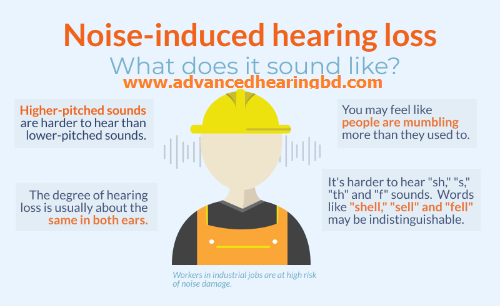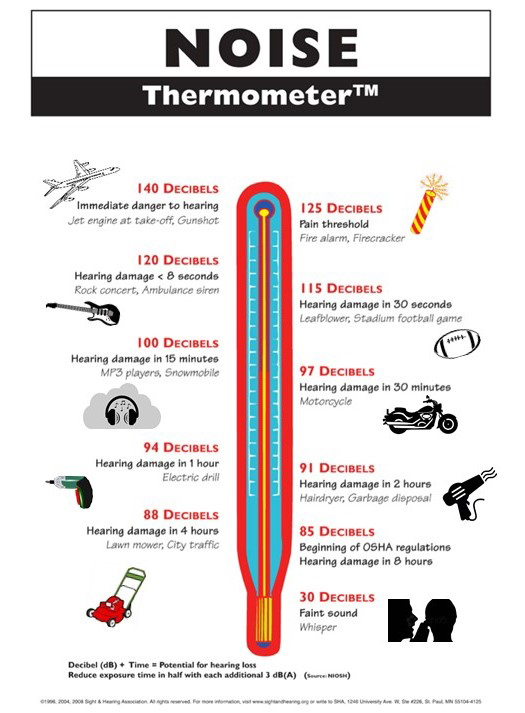One of the most common types of hearing loss is noise-induced hearing loss. When the ear has been exposed to a high volume, the fragile sensory hair cells within the ear can be damaged. The noise can be extended over time, such as someone working with loud machinery at a job, or the damaging noise can be brief, like an alarm or gunfire. Extended or repeated exposure to sounds greater than 85 dB can cause hearing loss.
What is noise-induced hearing loss (NIHL)?
In simple terms, noise-induced hearing loss is permanent damage to the tiny hair cells in your ears, known as stereocilia, from loud sounds. Akin to earthquakes, hazardous levels of noise produce vibrations in the hair cells that are so powerful they are damaging—sometimes permanently.
Hair cells are not replaceable and do not regrow. Damaged hair cells are unable to trigger electrical signals to the brain, impeding hearing. Both intense but short noises—such as a nearby gunshot—and repeated or continuous exposure to loud noises—such as operating construction equipment—can damage the hair cells.
Symptoms of noise-induced hearing loss
Noise-induced hearing loss typically makes it harder to hear high-frequency sounds, which is easy to detect with a hearing test that can be charted on an audiogram. It will show a dip to the right, known as a noise-notch pattern.
Day to day, a person may struggle to hear speech, especially words with “s,” “f,” “sh” and “th” sounds in them. (For example, the words “shell” “sell” and “fell” are hard to distinguish.) You can hear, yet have trouble understanding what other people are saying, even if they’re raising their voice.
Other signs that you need to get your hearing tested by a hearing care professional include:
- You have pain in your ears following loud noise exposure.
- Other people comment that you’re talking loudly or shouting.
- You have tinnitus—ringing, whooshing, roaring or buzzing sounds in your ears.
- You may experience diplacusis, or “double hearing,” though this is rare.
Noise levels of common sounds
In general, people are advised against exposure to any sound above about 85 decibels, though it also depends on how long and how often a person is exposed, as well as how close they are to the sound. A hair stylist using a hair dryer at 70 dB all day can still develop hearing loss, for example, because of how long, how close and how often they are exposed.
The following graphic presents a visual of noise exposure and its threat to your hearing:
There is currently no cure for hearing loss. If you are concerned about noise exposure and your hearing health, you can take action in the following ways:
- Use disposable or reusable earplugs that are placed inside the ear canal and block out noise. Closely follow instructions on the earplug packaging to ensure your earplug is properly fit.
- Using sound isolating earbuds or earmuff headphoneswhen listening to a personal music device will block out environmental noise and allow you to listen to audio at lower volume levels.
- Turning down the volume on audio devices, no matter how you listen, can allow you to enjoy your audio for longer periods of time without the threat of hearing loss.
- Look for quieter products when purchasing power tools, home appliances, or sporting equipment.
- Give your ears time to rest after long exposure to noise. Just like giving rest to your body after a vigorous workout, it is also beneficial to give your ears rest. Researchers have found that ears need at least 16 hours of recovery after one loud night out.1
- Get your hearing checked by a professional, especially if you are frequently exposed to noise. Experts recommend that those between the ages of 18 and 45 should have their hearing tested once every five years. When you reach the age of 45 a hearing test is recommended once every three years, and those over 60 should have their hearing tested annually.
Common causes of noise-induced hearing loss
Workplace exposure
A staggering 1 out of every 4 American workers have been repeatedly exposed to dangerous noise, according to the Center for Disease Control and Prevention’s National Institute for Occupational Safety and Health, and about 12% of all workers have hearing difficulty. Eight percent have tinnitus (which can result from noise exposure). CDC data shows that jobs with the highest risk include:
- Mining and oil and gas extraction
- Agriculture
- Construction and carpentry
- Military: The VA provides hearing aids for veterans who qualify.
The Occupational Safety and Health Administration (OSHA) requires employers to have hearing conservation programs to limit employees’ hazardous noise exposure, including providing hearing protection equipment, maintaining machinery, placing barriers or isolating the noise source and developing a hearing conservation program to test employees’ hearing. Read more about OSHA hearing regulations here. If you are provided hearing protection at your place of employment, take it seriously. Noise-induced hearing loss can be prevented. You also may be entitled to workers’ compensation benefits for on-the-job hearing loss.
Is your hobby harming your hearing?
Things we do for fun can also cause NIHL, including hunting or shooting at a firing range, attending concerts, listening to loud music (or performing it), operating lawn and home improvement equipment, and riding motorcycles and snowmobiles.
Other harmful effects of loud noise exposure
Aside from damaging your hearing, research shows that noise pollution and NIHL can lead to:
- Stress
- Anxiety
- Insomnia, even after the noise stops
- High blood pressure
- Increased heart rate
- Isolation due to hearing loss
- Depression due to hearing loss
Fortunately, research shows that hearing aids help with many of these health problems.
How many people have noise-induced hearing loss?
Statistics show about 40 million US adults aged 20-69 years have noise-induced hearing loss.
How to prevent noise-induced hearing loss
Noise-induced hearing loss is usually permanent, so it’s important to take precautions to protect your ears. There are several solutions available for people who anticipate being in loud noise situations, including:
- Disposable foam earplugs, which are placed in the ear canal, can be purchased at drug, hardware and sporting goods stores. They come in different sizes and lower noise levels by 15 to 30 decibels, which is beneficial in most situations, but not all. Earplugs can also be custom-molded to fit your ears by a hearing healthcare professional.
- Earmuffs, which fit completely over the ears and form a seal, lower noise levels by 15 to 30 dB. You can pair earmuffs and plugs together for better noise reduction.
- Replacing loud machine parts and using lubricant can reduce friction and lower noise. Many cars, farm equipment and other machinery have mufflers, silencers and bearings that can lessen the sound.
- Turning music down. Earbuds inserted directly into the ear canals put loud music right at the eardrum. Be conscious of how loud your music is, and never use music to block out other unwanted sounds.
- Be mindful. Once you become aware of noise hazards, you will notice them everywhere and can take action. For example, avoid walking directly by active construction sites and cross the street instead. If you’re stuck in traffic on a busy highway, roll up your car windows for a quieter ride. Wear inexpensive foam earplugs while mowing the lawn or operating a leaf blower.
How do you treat noise-induced hearing loss?
Noise-induced hearing loss is, unfortunately, permanent. Typically the best treatment for NIHL is properly fitted hearing aids. Today’s technology works better than hearing aids of decades ago, and solutions are widely available for every budget and lifestyle need.
If you already have hearing loss, find a hearing care provider near you and make an appointment.








